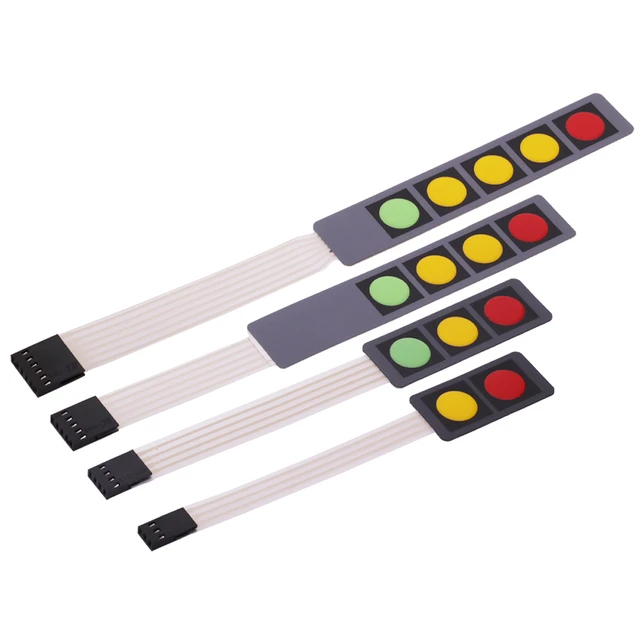Choosing the Right Membrane Switch for Your Business Needs
Choosing the Right Membrane Switch for Your Business Needs
Blog Article
Understanding Membrane Switches Over: The Key to Long Lasting and Dependable Controls

What Are Membrane Layer Switches?
Membrane switches are an advanced option in the world of interface innovation, integrating capability and layout flawlessly. These devices function as a user interface in between users and digital systems, integrating several components right into a compact format. Generally constructed from flexible, thin layers of materials, membrane layer buttons are created to reply to touch, making it possible for customers to connect with equipment and digital tools successfully.
The main aspects of a membrane switch include a printed circuit layer, graphic overlay, and a spacer layer that prevents unintended activation. The visuals overlay can be personalized to show brand identity or customer choices, improving aesthetic appeals while making sure functionality. Membrane buttons are frequently used in various applications, including medical tools, customer electronic devices, and industrial devices, owing to their longevity and resistance to ecological elements such as moisture and dirt.
One of the key advantages of membrane layer switches is their ability to hold up against deterioration, making them perfect for high-traffic environments. Additionally, they are light-weight and require marginal area, allowing for ingenious designs in product advancement. Overall, membrane layer switches stand for a sensible and reliable choice for modern-day electronic user interfaces, marrying modern technology with user-centric layout principles.
Exactly How Membrane Layer Changes Work
The procedure of membrane layer changes joints on a straightforward yet effective system that equates customer input into digital signals. When a user presses the switch, the top layer warps, enabling a conductive component in the circuit layer to make call with a corresponding conductive pad on the underside of the graphic overlay.
The style of membrane switches can vary, but they commonly include domes or responsive components to offer comments to the user, improving the general experience - membrane switch. The products utilized in membrane switches, such as polyester or polycarbonate, add to their toughness and resistance to ecological variables, consisting of dampness and dust. The published circuits are normally enveloped, which secures them from wear and tear over time.
Benefits of Membrane Switches

Additionally, membrane switches are understood for their toughness. Created from durable products, they are immune to dust, wetness, and physical wear, which dramatically expands their life-span contrasted to typical mechanical buttons. This toughness makes them specifically appropriate for high-traffic settings and applications calling for long life.
One more considerable advantage is the convenience of cleansing and upkeep. The smooth surface of membrane switches minimizes dust accumulation and is frequently unsusceptible spills, making them perfect for settings that call for constant sanitization.
Additionally, membrane switches offer a structured account, resulting in a thinner design that can be incorporated into various devices without including bulk. This feature not just improves the aesthetic allure yet likewise contributes to an extra ergonomic item design.
Applications of Membrane Layer Switches
Straightforward and flexible, membrane buttons find applications throughout a vast array of industries, consisting of medical tools, consumer electronic devices, and commercial tools. In the medical area, these switches are integral to tools such as diagnostic devices, individual monitoring systems, and mixture pumps, where dependability and ease of cleansing are vital. Their ability to keep and hold up he said against severe settings performance makes them perfect for such applications.

In customer electronics, membrane layer buttons are utilized in items like microwaves, cleaning machines, and push-button controls - membrane switch. Their streamlined style enables instinctive individual interfaces, boosting the overall user experience while supplying sturdiness and resistance to tear and wear
Industrial devices additionally profits from membrane switches, especially in control panels for equipment and automation systems. These buttons offer protection against dust and wetness, making certain consistent performance in difficult atmospheres. In addition, their customizable features allow makers to customize them to details functional demands, boosting performance and capability.
Choosing the Right Membrane Layer Switch Over
When picking a membrane layer button, it is necessary to take into consideration different elements that influence performance and suitability for specific applications. The key factors to consider consist of ecological conditions, tactile find this comments, sturdiness, and style specifications.
First, assess the operating atmosphere; buttons revealed to wetness, chemicals, or extreme temperature levels call for certain websites materials to ensure longevity and capability. Next, evaluate the demand for tactile feedback. Relying on customer communication, some applications may take advantage of a responsive response to validate activation, while others may prefer a non-tactile layout for aesthetic reasons.
Longevity is one more crucial variable; membrane switches ought to be made to withstand regular use, effects, and abrasion. Ensure the picked button can withstand the anticipated lifecycle, especially in high-usage circumstances.

Final Thought
In conclusion, membrane changes serve as crucial components in the style of trusted and durable control systems across different sectors. The flexibility of membrane changes permits for customized solutions that meet particular functional needs, reinforcing their importance in contemporary innovation.
Membrane layer switches represent a crucial element of modern-day user interface layout, mixing capability with resilience in various applications.Membrane switches are an advanced option in the world of individual interface innovation, incorporating capability and style effortlessly. Typically constructed from flexible, thin layers of products, membrane layer buttons are created to react to touch, allowing users to communicate with equipment and electronic gadgets successfully.
The style of membrane switches can differ, yet they usually include domes or responsive aspects to offer feedback to the user, boosting the general experience.In final thought, membrane switches offer as necessary elements in the design of resilient and dependable control systems across various sectors.
Report this page